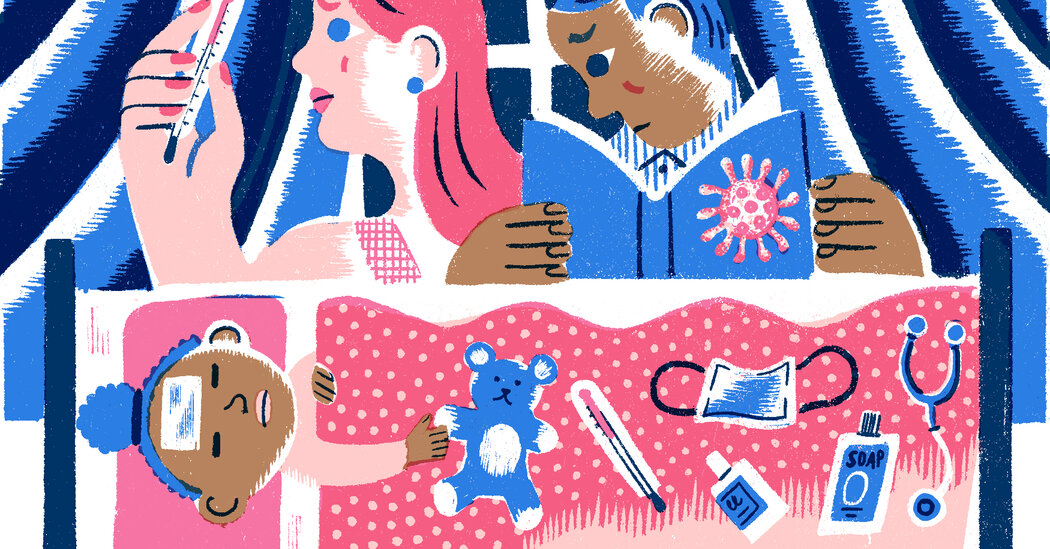It’s inevitable. In the fall and winter your child is likely to develop a fever, runny nose or cough. Maybe even all three.
In past years, that probably wouldn’t have been so worrisome. Usually children are sent back to school as soon as they are well enough to attend. But now parents are bound to wonder: Are those symptoms a sign of Covid-19? Should my child stay home? Does she need to be tested? If so, how often? The rules at different schools may vary.
With cold and flu season quickly approaching and the school year already underway in many states, parents need to know what to do. So we asked three pediatricians if it’s possible to know whether your child’s symptoms might be Covid-19, and how to proceed if you think your child has the disease.
How will I know if it’s Covid-19, the flu or a cold?
You likely won’t. Because the symptoms of Covid-19 mimic so many other typical childhood illnesses, it’s really hard to tell.
“Unfortunately, there is no one very distinguishing feature,” said Eva Cheung, M.D., a pediatric cardiologist and critical care specialist at NewYork-Presbyterian Morgan Stanley Children’s Hospital and Columbia University Medical Center.
The most common Covid-19 symptoms in children are a cough or a fever, or both, according to the Centers for Disease Control and Prevention. The doctors we spoke with said they’ve often observed fever, diarrhea or congestion in children who have tested positive.
But there are a lot of other potential ways that the virus presents itself in children — symptoms can also include loss of taste or smell, abdominal pain, headache, sore throat and difficulty breathing. Some of those symptoms are also signs of other illnesses that circulate during cold and flu season. (A chart on the C.D.C.’s website shows just how often these symptoms can overlap.)
Remember that “parents know their children best,” said Meg Fisher, M.D., a pediatric infectious disease specialist and the medical director of the Unterberg Children’s Hospital at Monmouth Medical Center in Long Branch, N.J. If your child always gets allergies this time of year, for example, then it’s probably safe to assume that’s what’s causing her runny nose. But if your child’s symptoms seem out of the ordinary, it’s best to talk to your child’s pediatrician.
Latest Updates: The Coronavirus Outbreak
- Two P.R. experts at the F.D.A. have been removed after the fiasco over convalescent plasma.
- ‘We are incredibly concerned’: Local health departments urge the C.D.C. to pull its new guidance on testing.
- A Nevada lab confirmed the first coronavirus reinfection in the U.S., a case that included severe symptoms.
Some infected children won’t have any symptoms. A multicenter study of more than 400 hospitalized children in France found that 45 percent of the 22 children who tested positive for SARS-CoV-2, the virus that causes Covid-19, had none of the symptoms typically associated with Covid-19. This offers a clue as to how many children are potentially asymptomatic. But it’s difficult to know what percentage of children will be asymptomatic in the general population because we don’t know the total number of children who have had Covid-19 — many of them may have never been tested.
While it can be challenging for parents to identify Covid-19 symptoms from the usual cold or the flu, the Covid-related multisystem inflammatory syndrome, now known as MIS-C, has more distinguishable symptoms and characteristics. The condition, which affects children, is usually characterized by a fever of 101 or higher that doesn’t go away; a red rash; and abdominal pain accompanied by diarrhea and vomiting. The syndrome, however, is quite rare.
At what point should I keep my child home from school?
If your child has a fever, keep her at home. Even before the pandemic, most schools required children with fevers to be kept at home and remain there until their fever had subsided for at least 24 hours.
Before the coronavirus pandemic, kids would often go to school with lingering runny noses and coughs because cold symptoms can sometimes drag on for weeks. In most school settings, it was not expected, nor practical, for parents to keep their children home for three weeks if their kids felt well enough to attend school and didn’t have a fever.
But this school year is different, experts said.
“This is not the year to be sending your kid to school sick, even a little bit, even with mild symptoms, which I know is crazy. Because it’s really hard for parents,” said Adam Ratner, M.D., a member of the American Academy of Pediatrics’ Committee on Infectious Diseases and director of the division of pediatric infectious diseases at Hassenfeld Children’s Hospital at N.Y.U. Langone. “Sometimes mild symptoms are all we have to go on and kids are really good at shedding the virus, even if they don’t have symptoms. And so I worry about spread from kids who have mild symptoms within the class.”
Symptoms that warrant staying at home include coughing, runny nose, sneezing, vomiting, diarrhea or abdominal pain, regardless of whether or not your child has a fever.
“We actually don’t know whether or not the fever always comes first or it comes after,” Dr. Cheung said, referring to the progression of the disease.
Should my child take the antibody test?
Antibody tests are useful mostly for surveys of large populations to get a rough estimate of how many people have had the disease, not to make individual diagnoses, according to experts at the Infectious Diseases Society of America. The test isn’t helpful to parents wanting to know about their child’s ability to spread Covid-19. And, similar to adults, even if a kid tests positive for the antibodies, it’s unclear how protective the antibodies are or how long any immunity will last.
The test can, however, be used to help diagnose multisystem inflammatory syndrome, or MIS-C, in a child. New guidelines say that doctors should do both a Covid-19 test and an antibody test for MIS-C on children suspected of having MIS-C because it is not known how long after the initial infection that the inflammatory syndrome begins.
“Most of the kids we’ve seen with MIS-C have been antibody-positive, but not all of them,” Dr. Ratner said.
When and how often should I make sure my child is tested for Covid-19?
It depends on several factors: what your school requires, how prevalent Covid-19 is in your area, and the ease and speed with which you can get tested.
If your child has a fever combined with other symptoms of Covid-19 like a cough, runny nose or abdominal pain, then you should call your pediatrician and discuss the possibility of getting tested. The tests do help guide policymakers in figuring out how safe it is for schools to remain open.
A negative test will provide some peace of mind. If the test is positive, then you will need to alert your child’s school immediately and plan to quarantine your child for at least 10 days, per the latest C.D.C. guidelines.
If the test is readily available in your area and you can get the results back quickly — meaning in a day or so — then it might make sense to test your child even if the symptoms are mild and there is no fever.
“The overarching advice is that you just have to err on the side of caution much more readily in cities and places where the infection rate is high,” Dr. Cheung said.
The Coronavirus Outbreak ›
Frequently Asked Questions
Updated August 27, 2020
-
What should I consider when choosing a mask?
- There are a few basic things to consider. Does it have at least two layers? Good. If you hold it up to the light, can you see through it? Bad. Can you blow a candle out through your mask? Bad. Do you feel mostly OK wearing it for hours at a time? Good. The most important thing, after finding a mask that fits well without gapping, is to find a mask that you will wear. Spend some time picking out your mask, and find something that works with your personal style. You should be wearing it whenever you’re out in public for the foreseeable future. Read more: What’s the Best Material for a Mask?
-
What are the symptoms of coronavirus?
- In the beginning, the coronavirus seemed like it was primarily a respiratory illness — many patients had fever and chills, were weak and tired, and coughed a lot, though some people don’t show many symptoms at all. Those who seemed sickest had pneumonia or acute respiratory distress syndrome and received supplemental oxygen. By now, doctors have identified many more symptoms and syndromes. In April, the C.D.C. added to the list of early signs sore throat, fever, chills and muscle aches. Gastrointestinal upset, such as diarrhea and nausea, has also been observed. Another telltale sign of infection may be a sudden, profound diminution of one’s sense of smell and taste. Teenagers and young adults in some cases have developed painful red and purple lesions on their fingers and toes — nicknamed “Covid toe” — but few other serious symptoms.
-
Why does standing six feet away from others help?
- The coronavirus spreads primarily through droplets from your mouth and nose, especially when you cough or sneeze. The C.D.C., one of the organizations using that measure, bases its recommendation of six feet on the idea that most large droplets that people expel when they cough or sneeze will fall to the ground within six feet. But six feet has never been a magic number that guarantees complete protection. Sneezes, for instance, can launch droplets a lot farther than six feet, according to a recent study. It’s a rule of thumb: You should be safest standing six feet apart outside, especially when it’s windy. But keep a mask on at all times, even when you think you’re far enough apart.
-
I have antibodies. Am I now immune?
- As of right now, that seems likely, for at least several months. There have been frightening accounts of people suffering what seems to be a second bout of Covid-19. But experts say these patients may have a drawn-out course of infection, with the virus taking a slow toll weeks to months after initial exposure. People infected with the coronavirus typically produce immune molecules called antibodies, which are protective proteins made in response to an infection. These antibodies may last in the body only two to three months, which may seem worrisome, but that’s perfectly normal after an acute infection subsides, said Dr. Michael Mina, an immunologist at Harvard University. It may be possible to get the coronavirus again, but it’s highly unlikely that it would be possible in a short window of time from initial infection or make people sicker the second time.
-
I’m a small-business owner. Can I get relief?
- The stimulus bills enacted in March offer help for the millions of American small businesses. Those eligible for aid are businesses and nonprofit organizations with fewer than 500 workers, including sole proprietorships, independent contractors and freelancers. Some larger companies in some industries are also eligible. The help being offered, which is being managed by the Small Business Administration, includes the Paycheck Protection Program and the Economic Injury Disaster Loan program. But lots of folks have not yet seen payouts. Even those who have received help are confused: The rules are draconian, and some are stuck sitting on money they don’t know how to use. Many small-business owners are getting less than they expected or not hearing anything at all.
-
What are my rights if I am worried about going back to work?
- Employers have to provide a safe workplace with policies that protect everyone equally. And if one of your co-workers tests positive for the coronavirus, the C.D.C. has said that employers should tell their employees — without giving you the sick employee’s name — that they may have been exposed to the virus.
If a test comes back negative, then your child can most likely return to school quickly. Some schools may even require that you get the test.
If you cannot get a quick test result then the test becomes less useful. Say you waited seven days for your child’s results and the test came back negative. You might assume that your child was in the clear. But what if your kid contracted the virus during the seven days you were waiting for your results?
Why not test asymptomatic kids for Covid-19?
The doctors agreed that testing asymptomatic kids semi-regularly or at random intervals throughout the year is not useful. And depending on the area where you live, tests could be in short supply.
Keep in mind that people can continue to test positive for Covid-19 months after they contract the virus, even when they are no longer contagious, the doctors said. In other words, if your child tested positive, you would have no way of knowing when she got the virus — unless, that is, you were testing your child every day, a costly strategy used by the N.B.A. (All three doctors interviewed said that daily testing for children is not feasible.)
“We’ve become so hooked on testing that people are getting the impression that testing somehow puts you in a bubble or protects you in some way,” Dr. Fisher said. “If you get tested, it’s only a moment in time.”
The C.D.C. advises asymptomatic people who were in close contact with someone with Covid-19 — meaning that your child was within six feet of that person for at least 15 minutes — to quarantine for 14 days from the day of the last exposure.
If your child is asymptomatic and was recently exposed to someone with Covid-19 and you would like to get tested, then it’s best to wait about five days after being exposed before getting the test because the virus may still be incubating in the body, Dr. Fisher said.
“I wouldn’t do it earlier because you’re going to get that false sense of security that you’re not infected — and you might be,” Dr. Fisher said.
Getting tested isn’t necessary for those who are asymptomatic, according to the C.D.C., even if you had close contact with someone with the disease. Exceptions, the agency noted, might be made for “vulnerable” individuals, or if health care providers or state or local public health officials recommend testing.
The agency also does not recommend universal testing of all students and school staff. The C.D.C. says that it’s not clear whether this testing provides any additional reduction in person-to-person transmission of the virus beyond other infection prevention methods like hand-washing, mask-wearing and distancing. The A.A.P. agrees.
Regardless of how vigilant you are and how careful the school is, it’s impossible to avoid the risk of illness entirely.
“We know when children get together, illnesses are going to spread from child to child,” Dr. Fisher said. “So what we want to do is mitigate, not eliminate risk. If we’re waiting to eliminate risk, we’re never going to reopen school.”



















